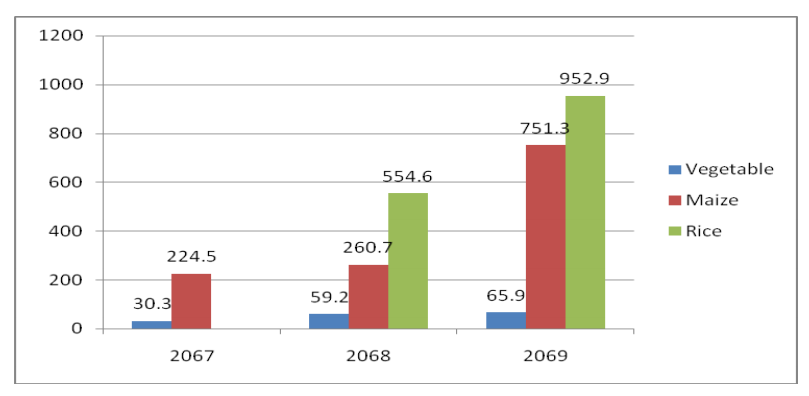Study of seed sector in Nepal

Seed can be defined as the fertilized mature ovule, consisting of an embryo, stored food, protective seed coat and a or a pair of cotyledons, which bear a capacity to germinate under favourable conditions. Seed is also a propagating material for growing healthy seedlings, tubers, bulbs etc. thus seed is a major, vital and crucial input for crop production. High quality seed help s in increasing both the production and productivity of crop adding appreciably amount of nutrients composition and Fooding material in them.
Importance of seed
Seed act as a bridge between two plant generations as it get produced from one and helps to produce same other off springs. A good and quality seed is the easiest and cheapest input among all other inputs as it requires less effort and management practices than any other. Quality seed hold great potential to carry both the physiological and genetical characters in which they possess great vigour, disease and pest resistant capability. Besides all these, quality seed possess following characters:
- They are genetically pure with high yield potential, evenness in growth pattern, maturity etc.
- The seed are free from seed borne disease and physiological disorders.
- Quality seed have bold uniform size, shape, colour, texture and weight.
- The seed must be free form inert materials like dirt, trash, soil etc.
- Seed should be fresh as much as possible.
- Seed must contain required amount of moisture.
- Seed should have good vigour, viability and health.
Seed system in Nepal
Nepalese seed system comprises two seed system:
First one informal seed system, which is also called the farmers seed system. It includes the majority share of the Nepalese seed system and another is a formal seed system. The contribution of the formal seed system to the total sector is very low. There is often a mismatch between the crop variety in demand by the farmers and seed variety in offer by the formal sector. In informal seed system seeds are produced and preserved by the farmers themselves for the subsequent planting. The seeds are bartered within the farmers as the informal network exists in this system for seed flow. The formal seed system in Nepal is characterized by the production, processing and distribution of registered varieties in demand with the precise quality control mechanism. Transaction wise formal seed system at present contributes more than 90 percent in Nepalese seed system and function as a leader in spreading new varieties (Seed Vision, 2013-2025). In formal seed system, NARC and other source seeds from stations under the department of agriculture produce breeder’s seed. contract seed production by National Seed Cooperation, private seed companies (e.g. Annapurna Seed Company Pvt. Ltd. SEA seed Pvt. Ltd.), in some cases farmers cooperatives (Budan Cooperatives Ltd., Bardiya, Udhyamshil Cooperatives Ltd., Dang) and non-government organizations (e.g. CEAPRED, Kathmandu, LiBIRD, Pokhara, FORWARD, Chitwan). In addition, several program play important role in seed production and distribution system such District Level Seed Self Sufficiency Program (DISPRO), Community based seed production program and government and donor-funded projects also add into the formal seed system in Nepal.
Seed statistics in Nepal
Due to inadequate seed use education, resource allocation, and human resource development, the use of good quality seeds at the farm level is reduced. Seed sector lacks mechanisms for the collection of information on seed use and conduction of seed survey. The data published by the MoAD provides annual coverage of area by improved varieties of three major food crops (rice, maize, wheat), but not the actual annual use of improved seeds at the farm level. Furthermore, the current estimation of seed replacement rate in Nepal is based on seed production and sales data instead of field survey data. Hence, empirical information on seed replacement rate actually at the field level and variety replacement data is currently unavailable. However, the available evidence and observation indicate that the use of good quality seeds at the farm level is very low due to limited access and poor knowledge of farmers. The use of hybrid seeds is common in maize, rice, and vegetables mostly in market accessible areas of Terai and river valleys. Crop area under hybrid seeds in maize and rice was estimated to be 10 percent and 2 percent, respectively in 2010. Hybrid vegetable seeds are used in 60 percent area of the commercial production pockets. The current status and projected area under hybrid seeds is:

Seed import situation
Nepal is importing seeds since very long and import is increasing in a geometrical ratio. Both in value and in volume, rice seed has the largest share in total import followed by maize in volume while vegetable in value.

Since Nepal is an agricultural country and farming is the soul culture here. So, quality seed play a vital role for feeding growing population. In this pandemic situation, quality seed import and export is halted at some level which suggest and recommend us to be productive on ourselves. As Nepal is producing quality seed as well but at small scale and the import of seed is more than the exports. Nepal possess various indigenous and high value crop seed, which can be formulated again to new variety by involvement of governmental and private organizations. For this, government of Nepal (MoAD) plays a vital role in providing opportunity, funding, subsidies to all the organization and farmers involving in production of seed. Yet Nepal has been producing less seed via formal system of seed production, informal system of seed production should also be encouraged to fulfil the seed demand.
Writer: Sabin Dhital (Institute of Agriculture and Animal Science, Lamjung Campus)

